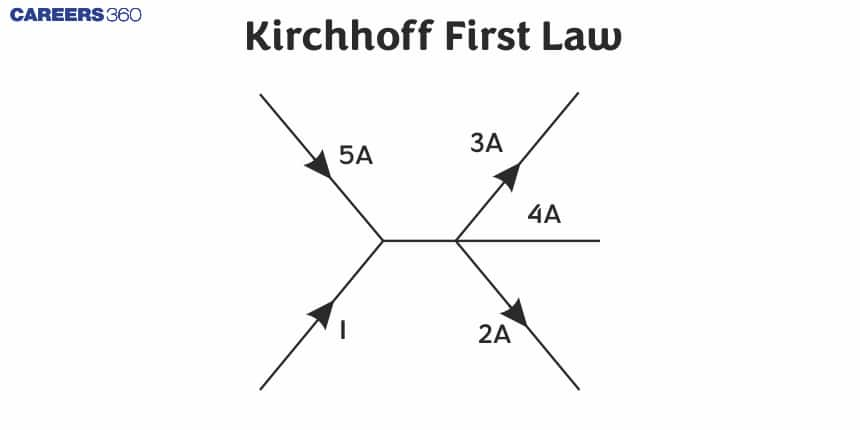Kirchhoff First Law
Kirchhoff's first law states that the algebraic sum of the currents meeting at a point in an electrical circuit is always zero. It is also called the junction rule. This law is based upon the fact that in an electrical circuit, a point can neither act as a source of charge nor the charge accumulate at that point.
This Story also Contains
- What is Kirchoff's First Law?
- Solved Examples Based on Kirchoff's First Law
- Summary

In this article, we will discuss the working conditions of Kirchhoff's first law. it helps us analyze and solve complex circuits by ensuring the conservation of electric charge and solving some important examples related to Kirchoff's first law. It is an important concept of current electricity for those who are preparing for class 12, NEET and JEE Main exams. Over the last ten years of the JEE Main exam (from 2013 to 2023), a total of three questions have been asked on this concept. And for NEET one question was asked from this concept.
What is Kirchoff's First Law?
In a circuit, at any junction, the sum of the currents entering the junction must equal the sum of the currents leaving the junction. This law is also known as the Junction rule or current law (KCL).

Recommended Topic Video
Solved Examples Based on Kirchoff's First Law
Example 1: In the given figure, which of the following relation is correct?

1)
2)
3)
4)
Solution:
In a circuit at any junction, the sum of the currents entering the junction must equal the sum of the currents leaving the junction.
This law is also known as the Junction rule or current law
Total incoming current = Total outgoing current
Hence, the answer is option (3).
Example 2: The Kirchhoff's first law
1) conservation of charge, conservation of energy
2) conservation of charge, conservation of momentum
3) conservation of energy, conservation of charge
4) conservation of momentum, conservation of charge.
Solution:
Kirchoff's first law
wherein

Kirchhoff's first law
Kirchhoff's second law
Hence, the answer is option (1).
Example 3: In the given circuit diagram, the currents, I1 = -0.3 A, I4 = 0.8 A and I5 = 0.4 A, are flowing as shown. The currents I2 , I3 and I6 ,respectively, are :

1) -0.4 A, 0.4 A, 1.1 A
2) 1.1 A -0.4 A, 0.4 A
3) 0.4 A,1.1 A,0.4 A
4) 1.1 A,0.4 A,0.4 A
Solution:
Apply Kcl at Q
I6+I3 = I1+ I2 .........(1)
I1 = 0.3A
I4 = 0.8A
I5 = 0.4A
KCL at 5
I4= I5 +I3
I3 = I4 - I5
= 0.8 +0.4
=0.4A
KCL at R
I1+I2 = I4
I2 = I4 - I1
= 0.8 - (-0.3)
=1.1A
From equation (1)
I6 + I3 = I1+ I2
I6 = I1 + I2 - I3
= -0.3+1.1 -0.4
=0.4A
I2 = 1.1A
I3 = 0.4A
I6 = 0.4A
Hence, the answer is option (4).
Example 4: When the switch S, in the circuit shown, is closed, then the value of current I (in amperes) will be:

1) 5
2) 3
3) 4
4) 2
Solution:
By KCL
i1 + i2 = i
Let voltage at C be V
12.5 = 1.25 V
V = 10 volt
Hence, the answer is option (1).
Example 5: The value of current in the $6\; \Omega$ resistance is :
1) 4A
2) 8A
3) 10A
4) 6A
Solution:

Applying KCL at the junction with voltage x (assigned)

By KCL,
Current through the resistor is
Hence, the answer is option (3).
Summary
Kirchhoff's First Law, which is also called the Current Law, says that the sum of all currents going into any point of a circuit (or junction) is equal to the sum of all currents leaving it. It’s founded on the principle of conservation of electric charge - no charge can either be created or destroyed at these points. By applying the principles of Kirchhoff's First Law it is possible to determine unknown currents and analyze circuit electricity flow in circuits that are complex.
Frequently Asked Questions (FAQs)
To apply KCL, you identify nodes (points where multiple branches connect) in a circuit. Then, you write equations based on the currents entering and leaving each node. These equations are solved simultaneously with other circuit equations to find all unknown currents and voltages.
Kirchoff's first law works on the conservation of charge principle
Yes, this law is used for both AC and DC.
A junction, or node, is a point in a circuit where three or more conductors meet, allowing current to flow in and out.
